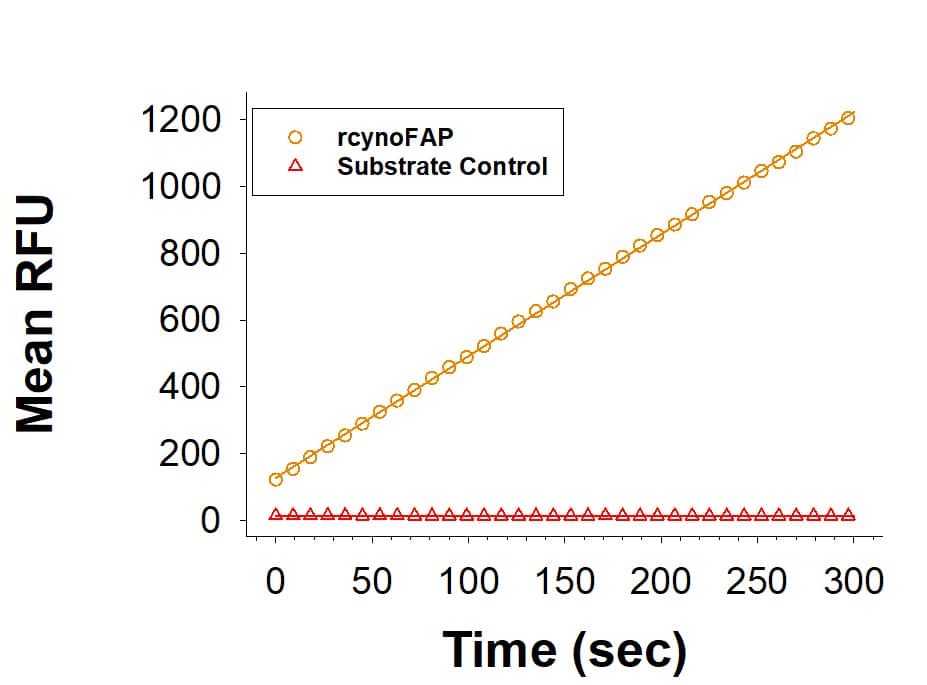Recombinant Cynomolgus Fibroblast Activation Protein alpha
R&D Systems, part of Bio-Techne | Catalog # 10278-SE

Key Product Details
Product Specifications
Source
Chinese Hamster Ovary cell line, CHO-derived cynomolgus monkey Fibroblast Activation Protein alpha/FAP protein
Leu26-Asp760
Leu26-Asp760
Purity
>95%, by SDS-PAGE visualized with Silver Staining and quantitative densitometry by Coomassie® Blue Staining.
Endotoxin Level
<0.10 EU per 1 μg of the protein by the LAL method.
N-terminal Sequence Analysis
Leu26
Predicted Molecular Mass
85 kDa
SDS-PAGE
87-94 kDa, under reducing conditions
Activity
Measured by its ability to convert the substrate benzyloxycarbonyl-Gly-Pro-7-amido-4-methylcoumarin (Z-GP-AMC) to Z-Gly-Pro and 7-amino-4-methylcoumarin (AMC).
The specific activity is >2500 pmol/min/μg, as measured under the described conditions.
The specific activity is >2500 pmol/min/μg, as measured under the described conditions.
Scientific Data Images for Recombinant Cynomolgus Fibroblast Activation Protein alpha
Recombinant Cynomolgus Fibroblast Activation Protein alpha Enzyme Activity
Recombinant Cynomolgus Fibroblast Activation Protein (Catalog # 10278-SE) is measured by its ability to convert the substrate benzyloxycarbonyl-Gly-Pro-7-amido-4-methylcoumarin (Z-GP-AMC) to Z-Gly-Pro and 7-amino-4-methlycoumarin (AMC).Formulation, Preparation and Storage
10278-SE
| Formulation | Supplied as a 0.2 μm filtered solution in Tris, NaCl and Glycerol. |
| Shipping | The product is shipped with polar packs. Upon receipt, store it immediately at the temperature recommended below. |
| Stability & Storage | Use a manual defrost freezer and avoid repeated freeze-thaw cycles.
|
Background: Fibroblast Activation Protein alpha/FAP
References
- Zi, F. et al. (2015) Mol. Med. Rep. 11:3203.
- Pineiro-Sanchez, M.L. et al. (1997) J. Biol. Chem. 272:7595.
- Lay, A.J. et. al. (2019) Front. Biosci. 24:1.
- Park, J.E. et al. (1999) J. Biol. Chem. 274:36505.
- Aertgeerts, K. et al. (2005) J. Biol. Chem. 280:19441.
- Keane, F.M. et al. (2011) FEBS J. 278:1316.
- Rettig, W.J. et al. (1988) Proc. Natl. Acad. Sci. USA 85:3110.
- Bauer, S. et al. (2006) Arthritis Res. 8:R171.
- Jiang, G.M. et al. (2016) Oncotarget 7:33472.
- Cheng, J.D. et al. (2002) Cancer Res. 62:4767.
- Kraman, M. et al. (2010) Science 330:827.
- Busek, P. et al. (2018) Front. Biosci. 23:1933.
Alternate Names
FAP, Seprase
Gene Symbol
FAP
UniProt
Additional Fibroblast Activation Protein alpha/FAP Products
- All Products for Fibroblast Activation Protein alpha/FAP
- Fibroblast Activation Protein alpha/FAP cDNA Clones
- Fibroblast Activation Protein alpha/FAP ELISA Kits
- Fibroblast Activation Protein alpha/FAP Lysates
- Fibroblast Activation Protein alpha/FAP Primary Antibodies
- Fibroblast Activation Protein alpha/FAP Proteins and Enzymes
- Fibroblast Activation Protein alpha/FAP Simple Plex
Product Documents for Recombinant Cynomolgus Fibroblast Activation Protein alpha
Product Specific Notices for Recombinant Cynomolgus Fibroblast Activation Protein alpha
For research use only
